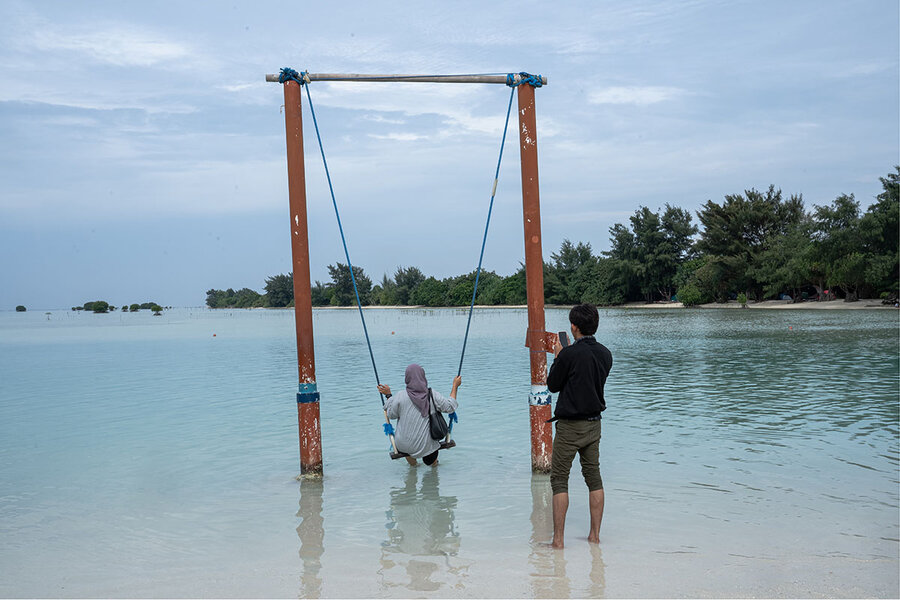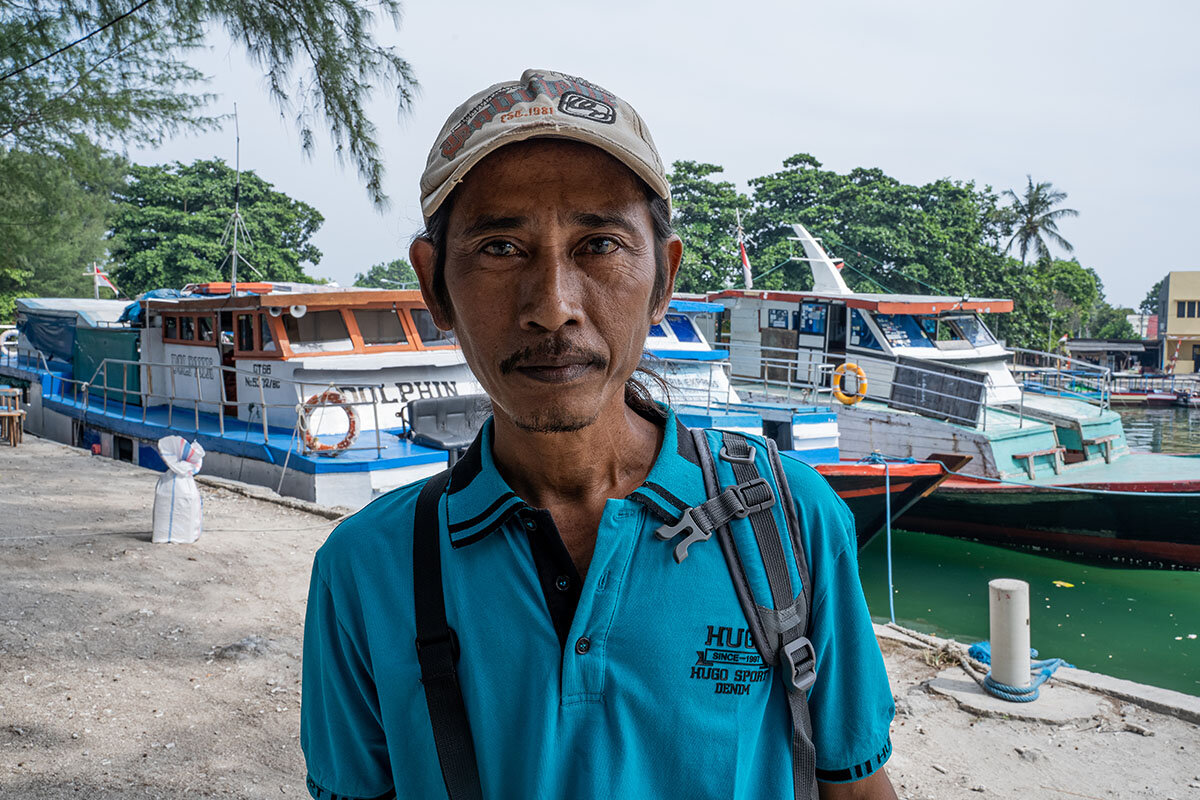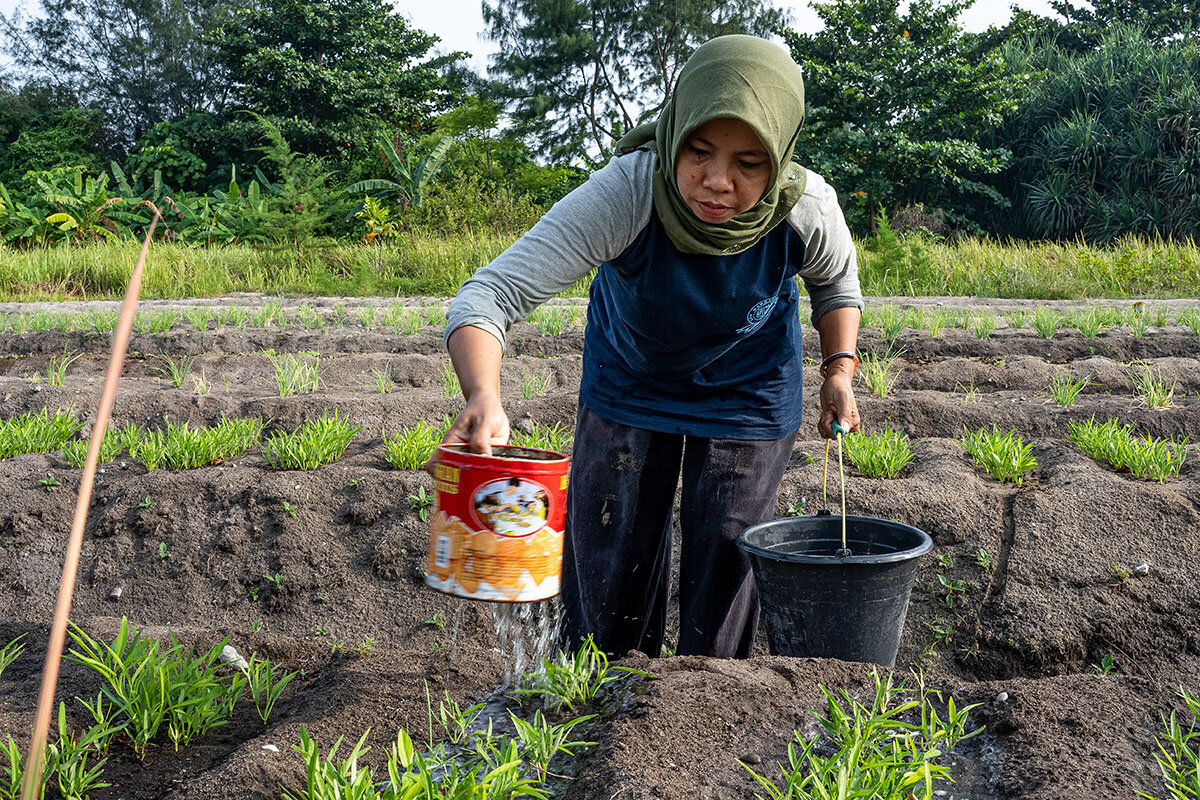When it comes to climate justice, one small island is thinking big
| Pari Island, Indonesia
Last December, Arif Pujiyanto was resting at his home on Bintang Beach, Pari Island – a popular vacation spot some 27 miles north of Jakarta – after a day’s work when he heard a neighbor shouting.
“Seawater is coming in!” they repeated.
Mr. Pujiyanto grabbed his sandals and ran out of his house only to find ankle-deep tidal flooding had already inundated his neighborhood. Within a few hours, the seawater reached his knees, flooded his kitchen, and engulfed most of the island, before receding in the early morning.
Why We Wrote This
A story focused onSmall island communities on the front lines of climate change are testing a novel tactic: challenging the multinational corporations that rank among the world’s top polluters. A first-of-its-kind lawsuit seeks to rebalance the scales.
“In my youth, rising tide was the most cherished moment,” says Mr. Pujiyanto, who now works as a welder but used to spend his days hopping between fishing boats, catching groupers, squids, and shrimp. “It’s the perfect moment to catch fish. But now the high tide moves in against us.”
Environmental groups say Pari Island has lost around 5 acres of land due to sea-level rise in recent decades, and most of the island could be submerged by 2050. But residents aren’t going down without a fight.
Four residents are suing Swiss concrete giant Holcim, demanding the company dramatically reduce its emissions and pay the plaintiffs a modest fee for climate-related damages. The case – the first in Indonesia to pit members of the public against a foreign private company through transnational litigation – is now headed to court in Switzerland, where it could take months to resolve. It follows a global trend; a report by the London School of Economics Grantham Research Institute on Climate Change and the Environment found that climate change lawsuits have more than doubled since 2015.
It also showcases an increase in public awareness on climate change and a desire for justice, says Agung Wardana, an environmental law expert and a Humboldt Fellow at Max Planck Institute for International Law in Heidelberg, Germany.
“This will be a landmark case in Indonesia,” says Mr. Wardana. “I think many others could follow suit in demanding accountability of major polluters. The homework to win the case is to find the causality between Holcim’s activities and its impact on Pari Island. That’s the challenge.”
An existential crisis
Experts say Indonesia, the largest archipelago in the world with more than 17,000 islands, will be among the hardest hit by climate change. Several islands have already been lost, and Indonesia’s Research and Innovation Agency states that around 115 will be submerged by 2050.
In recent decades, all major drivers of Pari Island’s economy have been threatened by climate change, including fishing and seaweed farming, the latter of which was a cornerstone of the island’s economy until the early 2000s.
Asmania, who goes by one name and is a plaintiff in the Holcim case, remembers how “dried seaweeds were lined along the road” during the ’90s, before warming sea temperatures and pollution took its toll on the crop. “They’re long gone and we can’t grow them back,” she says.
In the years since, tourism has largely filled the gap. An average of 2,000 tourists visit the tiny island each month, and the numbers increase considerably during holiday seasons, reaching more than 10,000 during Eid.
Weekends are the busiest time for fisherman Edi Mulyono. He and his wife provide tour packages around the island, as well as rent out guesthouses, snorkeling gear, and boats.
“It’s been a good business,” says Mr. Mulyono. “We manage all tourism attractions on Pari Island by ourselves without the help from the government, but local tourism is threatened as some guests canceled their trip when seawater breached.”
Mr. Mulyono observed that tidal floods have become higher since 2019, reaching over two feet in some areas, and increasingly difficult to predict. Changing weather patterns also made it harder to catch fish, forcing fishers to sail out more than 15 miles to get a good catch.
“Our ancestors know the seasons and the best time to catch fish just judging by the direction of the wind,” Mr. Mulyono says. “But now it becomes unpredictable. It’s not uncommon for us to come home empty-handed.”
Even though life was challenging for Pari Island’s 1,400 residents, many didn’t realize the extent of the problem until a community meeting with the Indonesian Forum for Environment (WALHI) in 2021. During the discussion researchers and activists from the nongovernmental organization presented data on rising sea levels and explained how carbon emissions from massive, multinational companies threatened the future of their island.
Armed with that information and the support of their neighbors, four residents partnered with WALHI, the European Center for Constitutional and Human Rights, and Swiss Church Aid in July of this year to take legal action, honing in on cement giant Holcim.
Finding justice in solutions
Holcim is among 100 top polluters in the world, known as Carbon Majors, alongside oil and gas giants such as Shell, BP, Anadarko, and others. With presence in over 90 countries, Holcim has emitted more than 7.1 billion tons of carbon between 1950 to 2021, according to research by the Climate Accountability Institute.
The company has been active in Indonesia since 2001, when it acquired national cement producer Semen Cibinong.
“Why Holcim? people asked,” says Puspa Dewy, head of WALHI’s research and legal division. “It is because the cement industry was the third major polluter after oil and gas. Holcim today is the largest cement producer in the world, and we demand their responsibility to further cut their emission.”
Experts argue there’s precedent for such demands.
Mr. Wardana says the Pari case bears resemblance to a 2015 lawsuit that Peruvian farmer Saúl Luciano Lliuya filed against German energy company RWE, as well as Milieudefensie et al v. Royal Dutch Shell. In May 2021, a district court in The Hague, Netherlands, ordered Royal Dutch Shell to reduce its global carbon emissions by 45% by 2030, becoming the first major climate litigation ruling against a corporation.
The plaintiffs demand Holcim cut its greenhouse gas emissions by 43% by 2030 and 69% by 2040. They also demand approximately $3,300 for each plaintiff in compensation for psychological and material losses.
Holcim has said it “takes climate change very seriously,” and “we significantly reduced our footprint over the last decade and will cut it further by 2030.” The mandatory conciliation period ended this month with Holcim rejecting the lawsuit’s demands. Having failed to reach an agreement, the next step is civil court, according to Parid Ridwanuddin, a coastal campaigner with WALHI.
Mr. Mulyono hopes that a court victory will pressure other major polluters, not just Holcim, to cut their global emissions. He says he and his neighbors want to live without fear of losing their island.
Local environmental activists also hope that raising the profile of Pari Island’s plight will remind Jakarta of the urgency of climate change. Its proximity to the capital “should be a warning to the government that the impact of climate change is right in front of the door,” says Mr. Ridwanuddin.
In the meantime, many Pari residents are doing their part to mitigate the effects of climate change.
Asmania and many other residents set up a local mangrove-planting initiative in the hopes of preventing seawater intrusion. They have planted thousands of mangroves on three beaches over the past two years, and plan to add more by collecting seeds from existing trees.
“We also offer tourists to donate some money in exchange for planting mangroves together,” she says. “I think this is a good way to raise awareness among tourists that we have to protect this island.”
This story was supported by the Pulitzer Center on Crisis Reporting.









